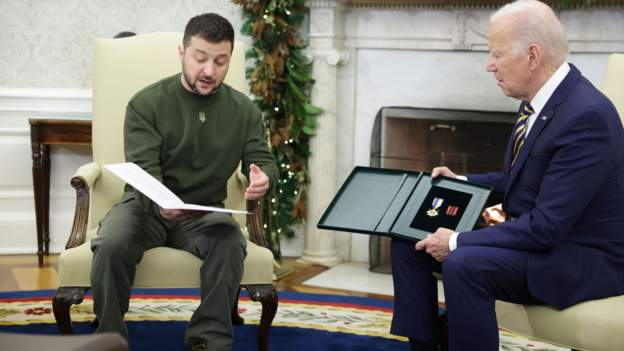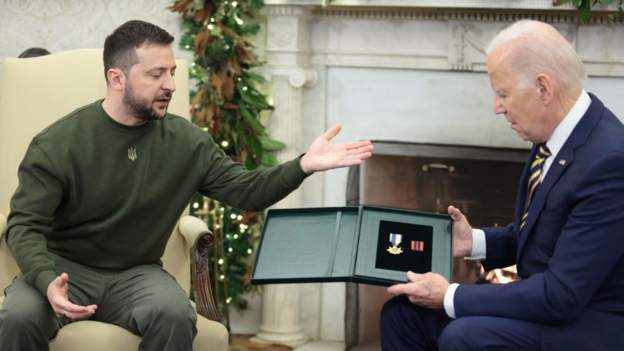|
Here's to another eight months of dunking on Russia from afar with posts as Ukraine dunks on Russia with HIMARS.
|
|
|
|

|
| # ¿ May 12, 2024 06:57 |
|
 Footage of a Russian convoy getting hit by rockets taken by a loitering drone (probably what was guiding the strikes). Footage of a Russian convoy getting hit by rockets taken by a loitering drone (probably what was guiding the strikes).   Somehow the Russians are still bunching vehicles up in the middle of roads. Somehow the Russians are still bunching vehicles up in the middle of roads.
|
|
|
|
Yeah reading between the lines it really seems like they were flying along and the missile just dropped off.
|
|
|
|
https://www.washingtonpost.com/world/2022/11/11/ukraine-sbu-traitors-russia-kharkiv/quote:KHARKIV REGION, Ukraine — The hunt for Ukrainians helping the Russians led the intelligence investigators to an idyllic village with a house on a hill, where the father of an accused traitor lives.
|
|
|
|
https://twitter.com/JakubKrupa/status/1592668115078639617
|
|
|
|
Unrelated to everything else, but finally some good news for Mariupol! https://twitter.com/mfa_russia/status/1592596951534817280
|
|
|
|
Russia and Ukraine are fighting the first full-scale drone war The article itself has some good visuals but I'll post it here in its entirety because it's fascinating. quote:KHARKIV, Ukraine — A war that began with Russian tanks rolling across Ukraine’s borders, World War I-style trenches carved into the earth and Soviet-made artillery pounding the landscape now has a more modern dimension: soldiers observing the battlefield on a small satellite-linked monitor while their palm-size drone hovers out of sight.
|
|
|
|
There's also this, but I think it may just be an ARG for an as-yet unannounced sequel to Event Horizon.
|
|
|
|
Orthanc6 posted:Yeah the US spent 2 decades in counter-insurgency wars that didn't need anything like the amount of ammo getting tossed in Ukraine. It's honestly surprising that the US military was planning to deal with Taiwan without these boosts to ammo production. They owe Ukraine not just for the business, but showing them just how far off their plans were for peer conflict well ahead of time. And not just for ammo, now we know we have to stock transformers and other infrastructure, and bring a bunch of manufacturing back in-country so they don't rely on a potential adversary. It really goes to show how for all the talk about China being the West's biggest future geopolitical rival, on an institutional level NATO militaries were still up until this year operating on the assumption that a peer or near-peer war would never happen again and it'd all be GWOT-type counter-insurgency operations for the rest of time. Really proves that adage about generals always being prepared to fight the previous war.
|
|
|
|
This looks like it'll be an interesting watch: https://www.youtube.com/watch?v=xJrWFn5lwU8 https://www.youtube.com/watch?v=Uq_Dkqbx2ik
|
|
|
|
https://twitter.com/nytpolitics/status/1603216293959712769
|
|
|
|
Willo567 posted:Is there any significance from the Tu-95 being launched from Engels? Absolutely none, Russia has been using strategic bombers to launch cruise missiles at Ukraine since the beginning and it doesn't matter which base in particular they take off from. You're letting some random tweet from a nobody get you worked up again.
|
|
|
|
Willo567 posted:Why does every opinion about Ukraine I read from a realist make it sound as though they just want to abandon Ukraine to be conquered by Russia? Because you keep seeking out random idiots on twitter and getting worked up by their hot takes!
|
|
|
|
Chalks posted:This is a guy who knows exactly what his role is in this conflict and does it extremely well Least surprising Time person of the year probably in my lifetime, that's for sure.
|
|
|
|
Here's the full story from Punchbowl:quote:
|
|
|
|
The US is passing a budget omnibus bill tonight: https://twitter.com/sahilkapur/status/1605341612367716352 https://twitter.com/JakeSherman/status/1605341140240240645
|
|
|
|
Here's some stuff I've come across this morning. Excerpt from Punchbowl's morning newsletter: quote:Happy Wednesday morning. https://twitter.com/wartranslated/status/1605237743885459456 https://twitter.com/ThomasVLinge/status/1605587464252403713 https://twitter.com/ThomasVLinge/status/1605588031204753408 What kind of armored vehicle is that? e: switched accounts for the speech video Moon Slayer fucked around with this message at 18:56 on Dec 21, 2022 |
|
|
|
Last one, with the brief clip of it repositioning.
|
|
|
|
https://twitter.com/PhilipWegmann/status/1605621711478497280Ynglaur posted:It's a T-72 variant of some kind with ERA blocks and anti-RPG cages on the rear side panels. Thanks! cr0y posted:This made me laugh a lot more than it should have. 
|
|
|
|
https://twitter.com/AmichaiStein1/status/1605630777856770048
|
|
|
|
https://twitter.com/mj_lee/status/1605640621217222679 https://twitter.com/Jordanfabian/status/1605640739777613825 Moon Slayer fucked around with this message at 20:09 on Dec 21, 2022 |
|
|
|
https://twitter.com/JenniferJJacobs/status/1605646202078433297 (Blinken is Secretary of State and Sullivan is National Security Advisor)
|
|
|
|
BBC posted:
|
|
|
|
https://twitter.com/PaulSonne/status/1605686804971245568 e: https://twitter.com/margbrennan/status/1605689477355245569 Moon Slayer fucked around with this message at 23:21 on Dec 21, 2022 |
|
|
|
https://twitter.com/mj_lee/status/1605692273617866752
|
|
|
|
 BBC posted:We reported earlier on the military award that Zelensky gave to Biden during their meeting - we've got more details on that now. Yeah it's choreographed propaganda, still made me smile.
|
|
|
|
On to Capitol Hill: https://twitter.com/AndrewDesiderio/status/1605703967115079680 https://twitter.com/kaitlancollins/status/1605704873625804800 Moon Slayer fucked around with this message at 00:23 on Dec 22, 2022 |
|
|
|
Baronjutter posted:More of a personal note, but we got the family out of Russia. It was some doing and not everything done was legal, but they're out of Russia. He's 59 so technically still of draft age and people absolutely do get shook down trying to leave russia at that age and forced to pay big bribes or just denied exit so we were a bit worried. We told them not to move to Russia, we begged them, but they didn't listen. Then again they owned a house just outside of Bucha so maybe this horrible move actually saved their lives. What a hosed world we're living in. I'm glad they're safe. https://twitter.com/AndrewDesiderio/status/1605705768036081665 This is what they're looking at, it's super neat.
|
|
|
|
Zelensky's address is about to get started.
|
|
|
|
It's a good speech.
|
|
|
|
https://twitter.com/ThomasVLinge/status/1605731770518978561
|
|
|
|
Yeah for such a choreographed event it got kind of awkward there at the end. Just a reminder that all of these larger-than-life figures are human, too, and sometimes need to figure out how to get off the stage on the fly.
|
|
|
|
mlmp08 posted:-The Ukrainian Patriot battery will not be linked into any NATO systems or communications. It is a battery for Ukraine to operate, on their own. And if you believe that, I've got a bridge from Russia to illegally occupied Crimea to sell you.
|
|
|
|
This whole thread is worth a read -- Tim Mak is a real pro follow -- but I found this really interesting: https://twitter.com/timkmak/status/1607017796403085312
|
|
|
|
The various articles about this do make the point that a lot of people are deliberately celebrating Christmas today at Russia.
|
|
|
|
Washington Post has another long article, this time about the two counter-offensives: https://www.washingtonpost.com/world/2022/12/29/ukraine-offensive-kharkiv-kherson-donetsk/ Some highlights, chosen at random because I found them interesting: quote:This reconstruction of the Kharkiv and Kherson counteroffensives is based on interviews with more than 35 people, including Ukrainian commanders, officials in Kyiv and combat troops, as well as senior U.S. and European military and political officials. quote:In the last days of August, Syrsky met in a large operations room in Ukraine’s east with his top aides and key brigade commanders. Before them was a 520-square-foot 3D-printed terrain map of the part of the Kharkiv region occupied by Russia. quote:U.S. intelligence helped ration the ammunition through accurate targeting. After many months, according to U.S. and Ukrainian officials, the two partners had worked out a real-time regimen: The Ukrainians would outline the types of high-value targets they were looking for in an area, and the United States would use its vast geospatial intelligence apparatus to respond with precise locations. quote:On Sept. 6, just past 3:30 a.m., Oleh’s company of about 100 soldiers, part of the 25th Airborne Assault Brigade, began to advance in small columns of three infantry fighting vehicles each. For hours before they started to move, Ukrainian artillerymen had been pounding Russian positions with U.S.-made M270 multiple launch rocket systems. quote:When Oleh’s company entered central Izyum, having made it there without any losses, the troops were dumbfounded at what lay before them: Tanks in working order, ready to be driven. Abandoned artillery pieces, ready to be fired. Fuel tankers “filled up to the eyeballs.” Tons of ammunition and light weapons. quote:Responsibility for that difficult stretch of front, northwest of Kherson, fell to Col. Vadym Sukharevsky, commander of the 59th Motorized Infantry Brigade. quote:Sukharevsky said he credits Ukraine’s victory partly to the artillery systems, guided munitions and long-range rocket launchers sent by the West, which eventually wore down a Russian force already low on ammunition and struggling with supply lines. quote:Ignatenko, the regional politician and Kherson shipping magnate serving in the 59th Brigade, sent a drone up over the river and found one of his barges half-submerged near the Antonovsky Bridge, but others were missing. Moon Slayer fucked around with this message at 19:13 on Dec 29, 2022 |
|
|
|
PederP posted:Head of the Danish Military Intelligence department of 'Russia Analysis' (difficult to translate the Danish wording) Informally this position would usually be referred to in English as the head of the "Russia desk."
|
|
|
|
https://twitter.com/JackDetsch/status/1611448756142239746 https://twitter.com/JackDetsch/status/1611448757186621441
|
|
|
|
It's also possible that maybe, just maybe, the people who are handling supply and procurement for Ukraine know what they're doing more than us randos here ITT?
|
|
|
|

|
| # ¿ May 12, 2024 06:57 |
|
Billboards in Ukraine, apparently the translation is "World of Courageous People" and then "Thank you for your support."      Reminds me of those WW2 "this man is your friend, he fights for freedom" posters.
|
|
|




